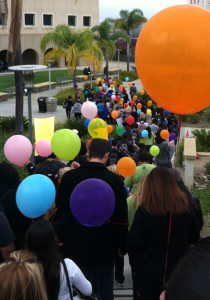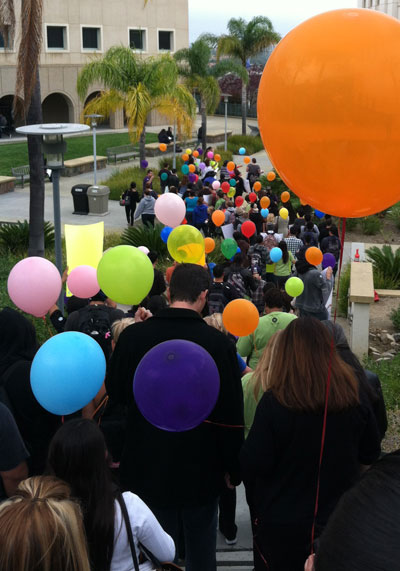
By Sarah Hughes & Katlin Sweeney
News Editor & Editor-In-Chief
Lavender Graduation spotlights accomplishments of lesbian, gay, transgender or intersex, questioning or queer and ally (LGBTQA ) students who are graduating at many universities.
In tracing the origins of Lavender, a nation-spanning story is told. Different locals celebrate the graduation and contributions of their LGBTQA campus communities in their own unique way. CSUSM’s Pride Center also has their own ceremony, known as Rainbow Recognition.
“LavGrad” as Lavender Graduation is colloquially called, is a celebration within a school’s Pride community or LGBT center. It is often open to friends, family, interested students and supporters called “allies”. It celebrates accomplishments of LGBTQA students in a more intimate setting than a official graduation.
According to LGBT Terms and Definitions, a webpage put up by the University of Michigan, “An ally is a person who is a member of the dominant group who works to end oppression in his or her own personal and professional life by supporting and advocating with the oppressed population.”
The University of Michigan’s list also has 19 other definitions “commonly used in American English” and notes that it is polite to respect others “desired self-identifications” by utilizing their preferred pronoun and “never assume another person’s identity based on that person’s appearance”.
The LGBTQA or LGBT is typically added to organization names to indicate an effort to include everyone, as opposed to just one group. In many cases, “allies” are heterosexual, the defining note is that they support the LGBTQA community as opposed to what their sexual preference is.
Dr. Ronni Sanlo, the creator of “LavGrad” was contacted on Twitter and Facebook about what inspired her to create the celebration in 1995. She has not responded at this time. The first ceremony was held at the University of Michigan, where Sanlo served as director of the LGBT Center. Sanlo owns Purple Books Publishing and wrote her memoir entitled The Purple Golf Cart: Stories of an Unconventional Grandma.
Megan Caldwell, GLBT resource center graduate assistant and public health graduate student at Texas A&M University explained possible origins of Lavender Graduation’s name in ‘Lavender Graduation’ to celebrate LGBT Graduates, Event to feature first Transgender Judge by Lindsey Gawlik.
“Lavender has had a history of being associated with the GLBT community,” Caldwell said. “The early feminist movement called lesbians the ‘lavender menace’ so it’s kind of been one of the colors that symbolize the community.”
Betty Friedan was the National Organization for Women (NOW) leader who coined the term “lavender menace” referring to her belief that combining lesbianism in with feminist agenda would undermine credibility of the women’s movement, as according to Lesbian History of University of Michigan. The site explains that during the Second Wave of feminism, feminist discourse largely ignored feminism and some feminists held hostile outlooks towards lesbians, while others saw lesbianism as a sexual issue, rather than one of politics.
“Others believed the project of feminism would dismantle strict sexual categories, and would release a “natural polymorphous sexuality,” making lesbian politics irrelevant.” said Lesbian History.
We contacted Jake Walker, the editor-in-chief of The Battalion Online, the student newspaper of Texas A&M University, regarding Gawlik’s Mar. 26, 2014 news story for comment. The story covered how the Texas campus’ GLBT Resource Center plans to celebrate the event, under Sidney Gardner, the GLBT Resource Center program coordinator, new leadership of a year. Gardner has wanted to introduce the ceremony since she first started working at A&M University, in order to give students a place to present their accomplishments as their “whole selves”. The keynote speaker at A&M’s “LavGrad” will be Phyllis Frye, Texas’ first transgender judge.
The CSUSM Pride Center has their own version of Lavender Graduation. It’s called “Rainbow Recognition” and is a special night to acknowledge graduates who have been involved with the Pride Center. As of Mar. 28, 2014, the staff hasn’t done any planning yet. The reception has been a tradition for a few years now.
The CSUSM Pride Center was contacted for a statement, but did not return the email at this time.
Other southern California universities have their own version of Lavender Graduation.
San Diego State University (SDSU) celebrated their fourth annual Lavender Graduation May 8, 2013. During the ceremony graduates receive a certificate and a rainbow chord to wear with their graduation cap and gown.
“Lavender Graduation is open to all students graduating in the spring semester or earlier who identify as lesbian, gay, bisexual, transgender, queer, or allies” said the SDSU website.
University of California San Diego has held a Rainbow Graduation in years past.Their LGBT Resource Center features available internship positions.
In a 2012 flyer that can be seen online for UCSD’s Rainbow Graduation details state, “Although many people do get dressed up for the event, it tends to be a queer little get together, with all the trappings of our community, so be yourself. We conclude our ceremony with a scrumptious spread of good food.”
Palomar has a LGBTQA Club on campus devoted to promoting “a safe and supportive environment for students of all sexual orientations”, educating the community and embracing diversity.
Though each ceremony is different, all celebrate LGBT students’ academic achievements and Pride center involvement, whether called a Lavender Graduation or a Rainbow Recognition ceremony.



http://Www.Mommyqa.com/questions/2290/traveling-planning-making-a-list-and-checking-it-twice • Sep 6, 2014 at 11:13 am
Aw, this was a really nice post. Taking the time and actual effort to
make a top notch article… but what can I say… I put things off a lot and never seem to get anything done.